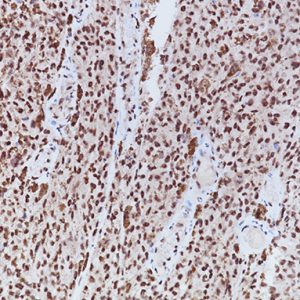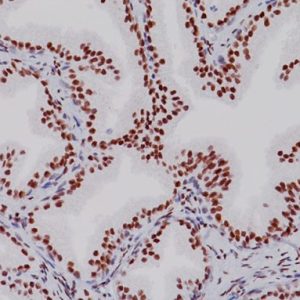Description
Programmed death ligand 1 (PD-L1, also known as CD274) inhibits tumor-reactive T-cells via binding to the programmed death-1 (PD-1) receptor, rendering tumor cells resistant to CD8+ T cell-mediated lysis (1). Studies have shown that the inhibitory receptor PD-1 is expressed on tumor-infiltrating lymphocytes (TIL) while PD-L1 is expressed on tumor cells. Assessment of PD-L1 expression in combination with CD8+ TIL density may be a useful predictive metric in multiple cancers, including stage III NSCLC, hormone receptor negative breast cancer and sentinel lymph node melanoma (2-4). Clinical trials utilizing humanized chimeric antibodies that block inhibitory checkpoints, such as anti-PD-1 and anti-PD-L1, have demonstrated delayed tumor growth and increased survival (5). While identification of PD-L1 overexpression by IHC is not yet standardized, it has become increasingly important to identify these tumors, as a directed therapy may improve clinical outcomes in these patients (6). In cutaneous melanoma, the targeting of PD-1/PD-L1 has provided meaningful clinical benefit for patients in just the past 5-10 years (7). The use of IHC for protein identification, along with novel therapies, such as checkpoint inhibitors and vaccines, are generating new options for the treatment of cancer patients. The PD-L1 [CAL10] clone does not cross react with PD-L2.
SPECIFICATIONS
Specifications
| INTENDED USE | IVD |
|---|---|
| FORMAT | Concentrate, ONCORE Pro, Predilute, UltraLine, VALENT |
| VOLUME | 0.1 ml, 1.0 ml, 20 ml, 6.0 ml, 60 Tests |
| SOURCE | Rabbit Monoclonal |
| CLONE | CAL10 |
| ISOTYPE | IgG1 |
| LOCALIZATION | Membranous/cytoplasmic |
| POSITIVE CONTROL | Lung adenocarcinoma or tonsil |
DATASHEETS & SDS
REFERENCES
References:
1. Ostrand-Rosenberg S, Horn LA, Haile ST. The programmed death-1 immunesuppressive pathway: barrier to antitumor immunity. J Immunol. 2014 Oct 15;193
(8):3835-41.
2. Tokito T, et al. Predictive relevance of PD-L1 expression combined with CD8+ TIL density in stage III non-small cell lung cancer patients receiving concurrent
chemoradiotherapy. Eur J Cancer. 2016 Jan 6;55:7-14.
3. Park IH, et al. Prognostic implications of tumor-infiltrating lymphocytes in association with programmed death ligand 1 expression in early-stage breast cancer. Clin Breast Cancer. 2016 Feb;16(1):51-8.
4. Kakavand H, et al. Tumor PD-L1 expression, immune cell correlates and PD-1+ lymphocytes in sentinel lymph node melanoma metastases. Mod Pathol. 2015 Dec;28
(12):1535-44.
5. Xia B, Herbst RS. Immune checkpoint therapy for non-small-cell lung cancer: an update. Immunotherapy. 2016 Feb 9 [Epub ahead of print].
6. Patel SP, Kurzrock R. PD-L1 expression as a predictive biomarker in cancer immunotherapy. Mol Cancer Ther. 2015 Apr;14(4):847-56.
7. Singh BP, Salama AK. Updates in therapy for advanced melanoma. Cancers (Basel). 2016 Jan 15;8(1).
8. Center for Disease Control Manual. Guide: Safety Management, NO. CDC-22, Atlanta, GA. April 30, 1976 “Decontamination of Laboratory Sink Drains to Remove Azide Salts.”
9. Clinical and Laboratory Standards Institute (CLSI). Protection of Laboratory Workers from Occupationally Acquired Infections; Approved Guideline-Fourth Edition CLSI document M29-A4 Wayne, PA 2014.











Reviews
There are no reviews yet.